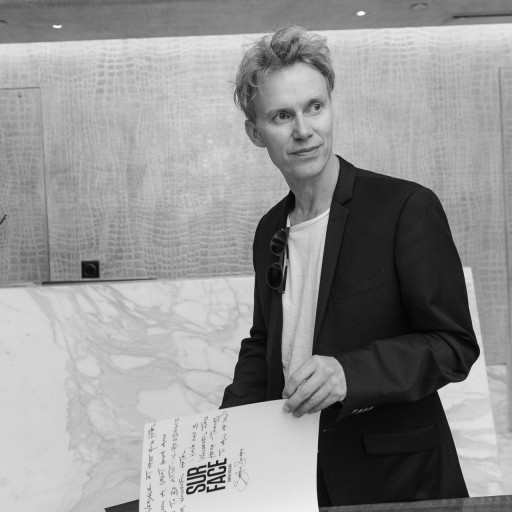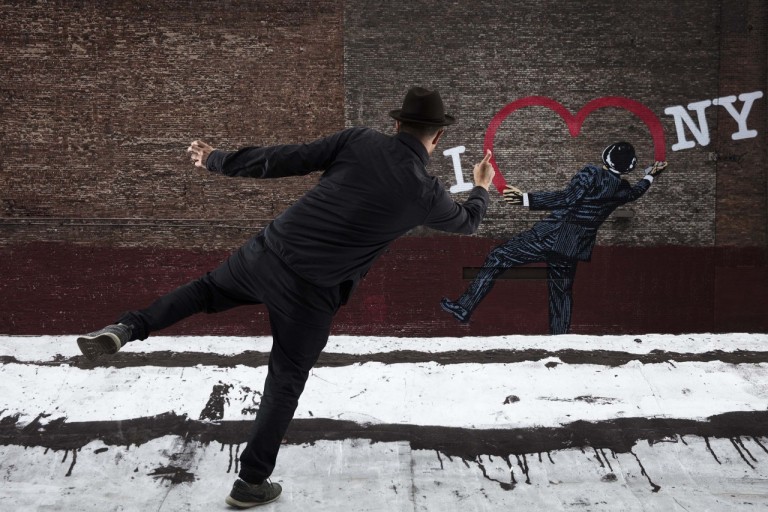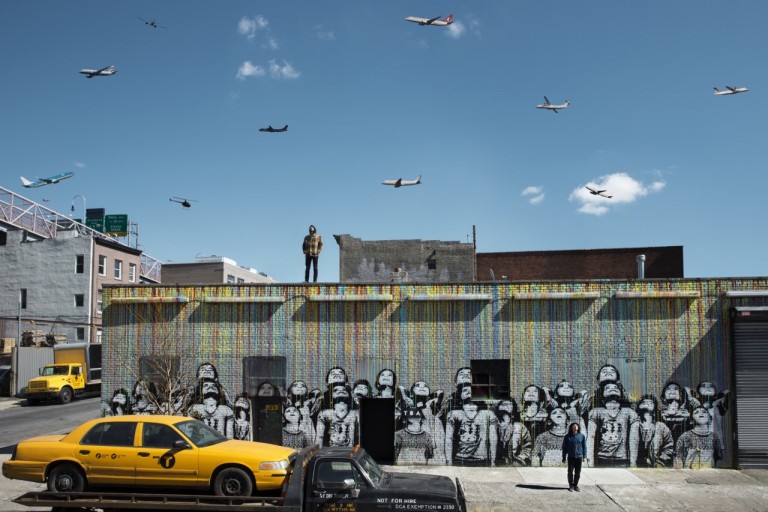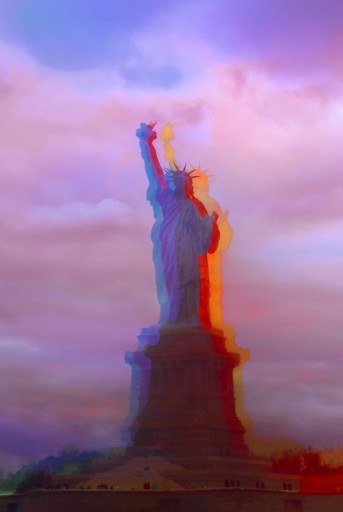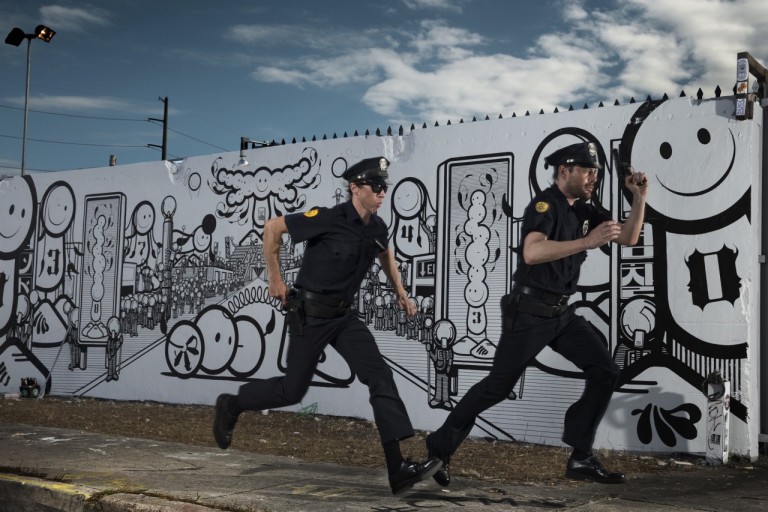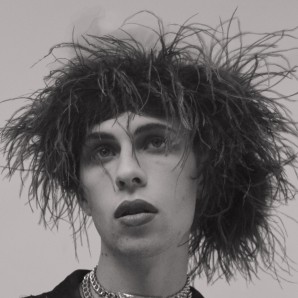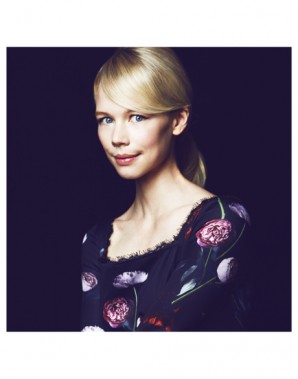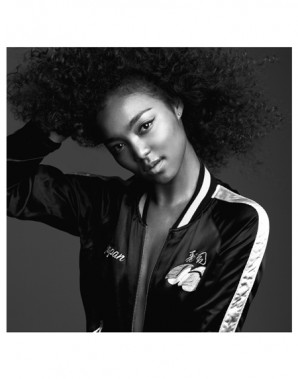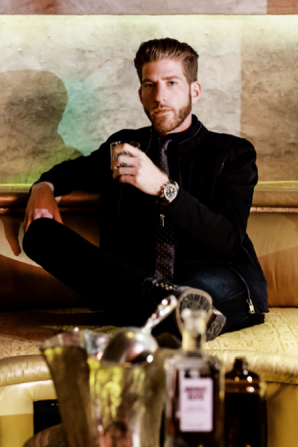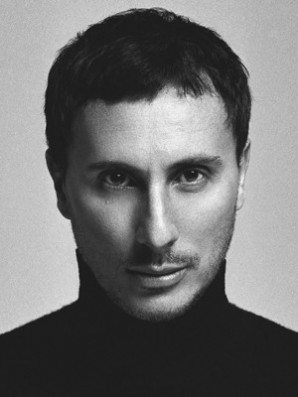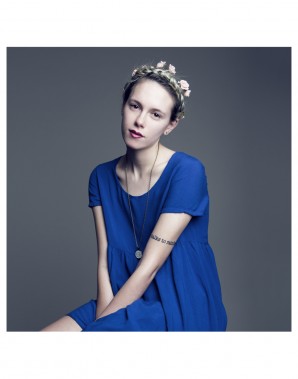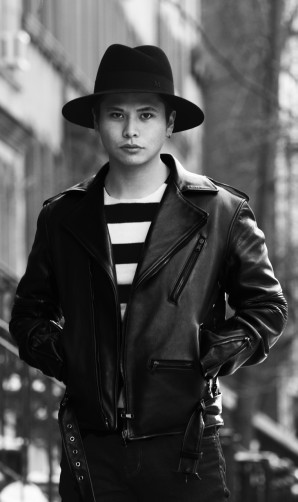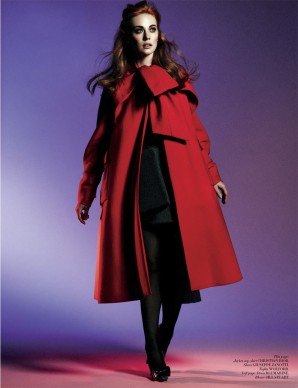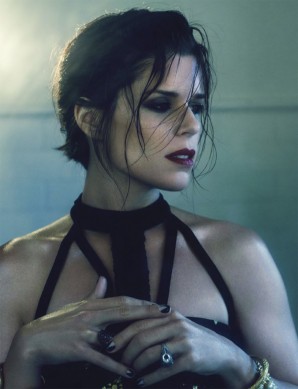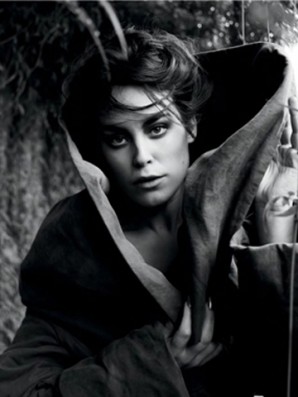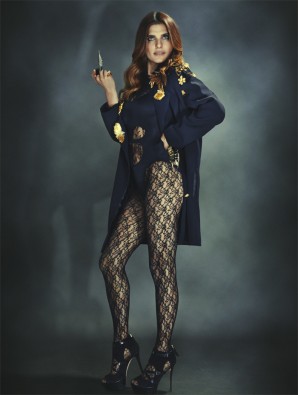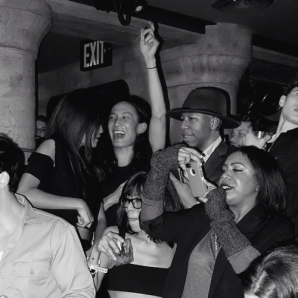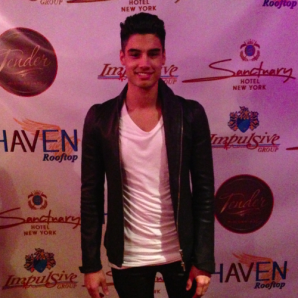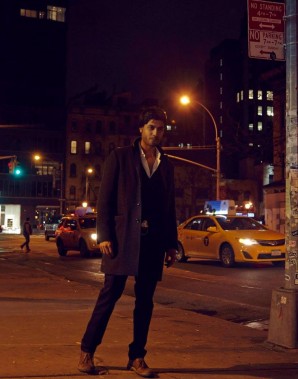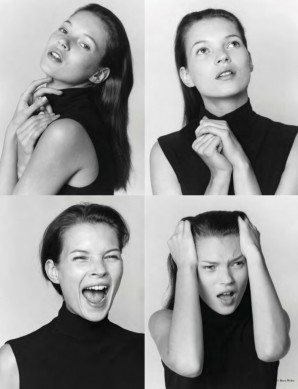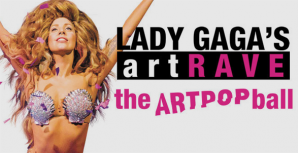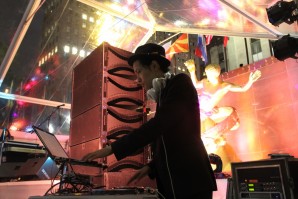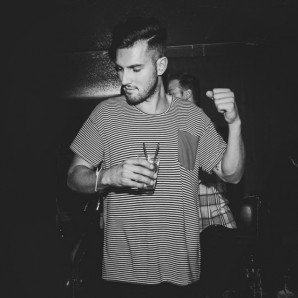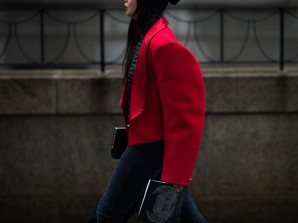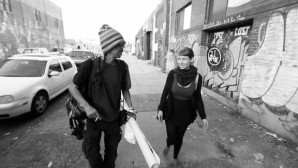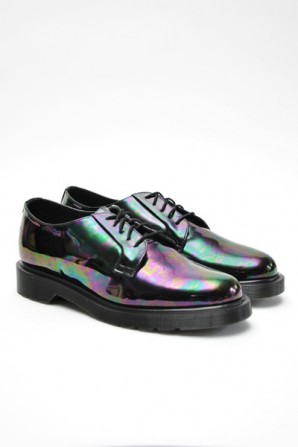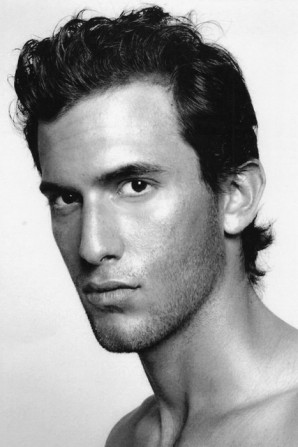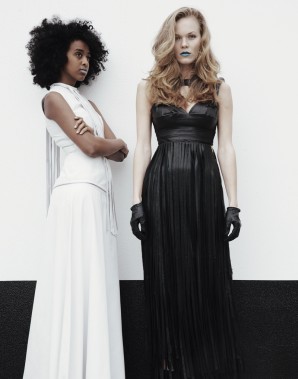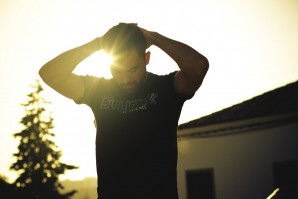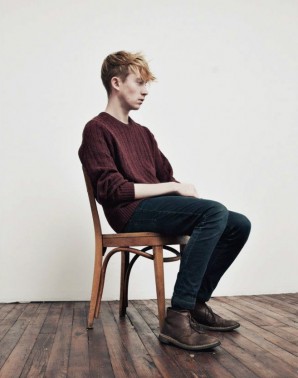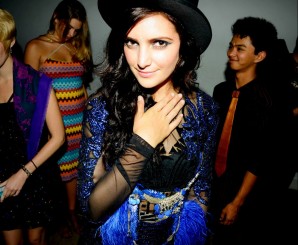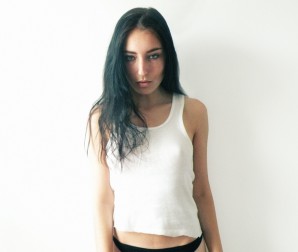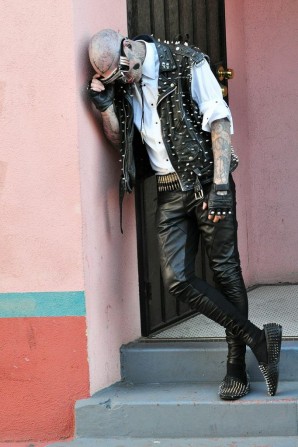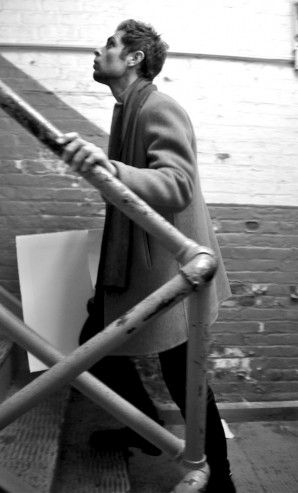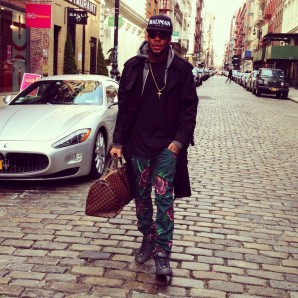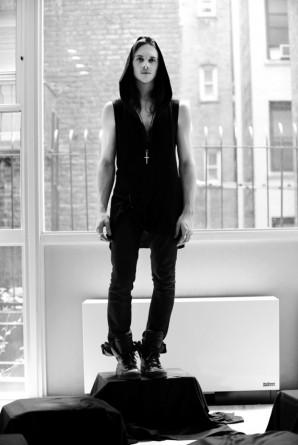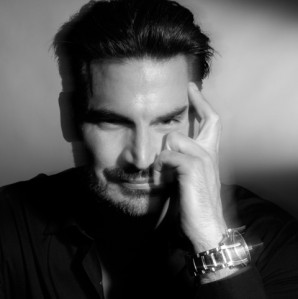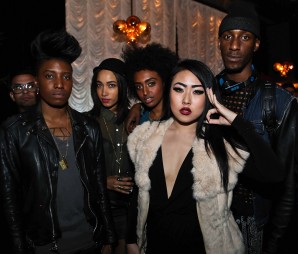TWELV takes a step back and visits the masterminds behind the camera.
Søren Solkær Interview
Stepping out of a cab into the urban symphony of Midtown, the entryway to The Quin Hotel was easy to spot— with classic architecture and bright satin flags swaying slowly in the summer breeze. There was a new exhibit on display called Heartbeat City, featuring photographs of the most recognizable symbols of New York, all with a distinct tone and colorful whimsy. Reminiscent of the iconic screen prints of the 60s, the modern, elegant lobby of The Quin had been transformed into a setting of cosmopolitan celebration. After exploring the lobby display and all of the other art locations throughout the hotel, I was escorted to interview Søren Solkær, the artist behind the dynamic photographs.
Audrey Rose at TWELV: Can you tell me a little more about your exhibit Heartbeat City?
Søren Solkær: Heartbeat City is the title for the whole lobby installation, but it’s mainly inspired by my new work. “Beat City” was the name of the first music video I ever did with The Ravenettes, and part of it was shot in New York. So it goes back to the late 90s or early 2000s. And the “Heart” part came from my love for New York. I’ve come back here maybe forty or fifty times. This image that I did of Nick Walker (also when I came to The Quin for the first time) had the very iconic heart in it, too.
A: What were your main sources of inspiration for the project?
SS: All of the work is done in New York City– whether its a photograph taken from an airplane, one of street artists or some of the most iconic spots in New York, or shots from the 90s. All the photographs are New York, as seen by me, across many projects and during quite a long period of time.
A: What keeps drawing you back to New York?
SS: I’m here a few times every year, and I know the city really well. Not quite like a local, but almost. I’m here that often. I’ve shot a lot in the streets, so I know a lot of the buildings and corners and the different neighborhoods. There’s just nothing like it. If I haven’t visited for 6 months, I find a reason to come back.
A: How have you experienced New York change since you first started coming here?
SS: It’s a good question, because it’s one that I can’t answer very well. I think I’ve changed a lot in the same period. When I started coming here, I was sleeping on friends’ couches. But I’ve always been mainly interested in the art and the street life, and I don’t really know how it’s changed– it’s just always been exciting! It’s always been this unlimited source of inspiration for me.
A: You originally started working as a photographer with Danish rock bands in the 90s. How was that experience?
SS: I started with Danish bands, but after a couple years of photographing in Copenhagen, I started working with English bands. It doesn’t take a long time to get acquainted with all the bands in Copenhagen– it’s a small place– so once I ran out of new exciting bands, I started working in London.
A: And that was when you transitioned from photographing mainly musicians to working more with artists and shooting street photography?
SS: Yes, but I’ve always worked with artists. Before I shot musicians, I did a project where I just photographed photographers. And in this work I photographed forty-five photographers. I’ve always been interested in working with other creatives, whether it be visual artists or actors or musicians.
— D.K. Johnston, the art curator at The Quin, joins the conversation. He sits across from Soren on the couch. After we all take a little break for small talk, we resume the interview.
A: Søren, what is it about The Quin that attracted your attention as an artist? What made this the perfect place to exhibit your work?
SS: It was a place that I started hearing about last year. I had never stayed here in the past, but some friends of mine showed here. I learned about the art program and that The Quin has a special relationship with artists. And then one day, Darren [D.K. Johnston] called me, and that’s really how it all started.
A: Did you have a say in where you wanted your art to be showcased within the hotel? Or was that more of the curator’s expertise?
D.K. Johnston: My hope is to have more and more different fingerprints on the visual process and the experience for the guests, so for someone with the aesthetic and design vision that Soren has, it was really mostly his own perspective on where to place things. We shared the history of different experiments that we’ve tried at the hotel– now that we’re almost to 20 of these solo shows– so it was a good base to work off of layout-wise, too.
SS: Yes, I had a pretty different plan when I arrived the first time, so actually it was something that developed over time, which made it really custom-made for the space. And the opportunity came up to show some work in the penthouse, and suddenly the hotel opened up even more, which was great.
A: You cite pop art as a source of influence for Heartbeat City, and we’ve seen pop art in its purest form shift towards something that’s more mass produced and used across immense media platforms. What are your thoughts on this evolution?
SS: I suppose it was pretty shocking when Andy Warhol did it, because he was using commercial printing techniques to create art– and that was shocking. But now I think it’s been absorbed, especially by street artists. Almost every other street artist has a studio practice as well, so these print-making techniques have really become part of it. Of course you can see Warhol’s fingerprints all over today’s art world even though it was many decades ago that he started doing it. I had a few different ideas for this new project about New York, but I ended up not going the printing way. Instead I did these multiple exposures that had been inspired by pop art prints, but using my camera.
DK: When I start to hear pop art tossed around in a dialogue on street art, my aspirations lean towards tying the two movements together. A lot of street artists have the same challenges that pop artists faced in the 60s, 70s and 80s– challenges of defining a movement. I tend to find that the same players in the movement have little to do with each other as artists, other than that they were alive at the same time. And street art struggles with that same kind of loose connectivity. There is a vast amount of nuance. This art is all collected and sold by the same group of people and followed by the same group of admirers. And pop art had this too, and it took a long time to formulate a valuable market around it. I think in street art, you have a movement that was born out of graffiti, and you have writers on that side like TAKI 183 or Cornbread who really have no commercial viability, but every person in the graffiti industry has to tip their cap to them for opening up the door. And I think that Soren has helped memorialize a lot of these artists.
A: Do you see politics as a major driving force in the street art community?
SS: They are driven by many many different things. Some are more aesthetics. Some are more political. Some are ego-driven. There are some artists that if you go into a certain kind of bar, be it in Prague, London, New York, you know you’ll find their stickers in the toilet. Say with Shepard Fairey and Obey, his stickers are found everywhere.
DK: And a lot of that is his tribe. His admirers buy his stickers and they’re proliferating his ideas. It’s pretty interesting. I’ve been working with all these artists and representing them for many years, and Soren has photographed many of them. This continuity and now being able to share the backstories and evolution has been a lot of fun. But the hope of trying to memorialize what’s going on here has been a real challenge, and Soren took on that challenge over a long period of time and did such a thoughtful job of telling their stories and capturing their work and the importance of it– I think it’s a cornerstone for the movement.
A: As an artist, what kind of impression do you want to make on people when they see your work?
SS: When we first talked about what I would show here, it wasn’t going to be work based on New York. It would be bringing another part of the world to this hotel to show what it’s like there. But, I felt like it made more sense to showcase New York because people staying at this hotel are from everywhere in the world. And at least while we’re all staying here, this is what we have in common. I wanted to offer my view and love for the city. That’s what I wanted to share.
DK: When we got started, we wanted to focus on celebrating the art heritage here. I compare it to the difference between hanging up taxidermy trophies and actually wanting to live with animals. You can hang cool art on the walls, but if you really want to feel like the creative class is here, then they have to be here. It’s a delicate balance. We really wanted to live with giraffes and rhinos and art in its natural habitat, and we’ve done it. The artists that work with The Quin interact with the guests and are involved in a lot of the events. That’s a level of authenticity that you don’t often see.
A: Both street artists and musicians often have reputations for their somewhat volatile personalities. How has your experience been working in such close collaboration with them?
SS: After having worked with musicians for so many years, I eventually worked with most of the ones I wanted to work with. And I also found that it was getting harder and harder to express myself in music photography, because there was more and more control. The higher you get, the more restrictive it is. Suddenly, there would be people at shows making sure you were where you were supposed to be and that just doesn’t interest me. The reason I started doing music photography was because I thought I had a lot of creative freedom there, but I felt like it had become very commercialized and controlled. During those years, street art started popping up everywhere. I started seeing all these great murals going up, and I started recognizing the work and recognizing the names, but I would know nothing about the artist. It’s so different from other art forms, because you don’t know what the artist looks like– you don’t know them. So I felt like this was the new place where the rock n’ roll types would go and express themselves. And I was right. The street artists are twenty times more rock n’ roll than the rockstars.
A: Was it challenging to transition into the street art world?
SS: In street art, at first, no one knew who I was. Basically I wanted to get back to creative freedom and creative collaboration. And that’s whats been really wonderful about this project. I’ve gotten to work with some amazing people with great ideas and crazy energy. And they’re up for anything. The second artists I shot for this project was like, “No, my face can’t be in there!” and I had never thought about that before. So, I had to find a new way of doing it, and the fact that so many street artists didn’t want their faces in the frame became a creative obstacle. But it made this project more interesting.
A: So you went from music to the new rock n’ roll, which you feel is street art. What do you think will be the new new rock n’ roll?
SS: Probably the not-so-established street artists. Things change when you get established, but I think the difference between going into a rehearsal with three guys and doing illegal work at night on a roof, risking your life and your freedom, to tell the world your name or about your dreams– I think it’s a much wilder thing to do than get a hit on the radio.
A: How do you think this style of photography, capturing street artists, will change in the future?
SS: I’ve done almost all of the shoots out on my own, just me and the artist, with maybe my girlfriend filming. And that was it. It was super simple. And it’s very likely that it won’t be possible to do that in 5 years. An army of photographers want to come up with the artists in the lift when they’re trying to finish the wall. Street artists are becoming stars, so it’s changing for sure. I think it’ll be harder to do what I’m working on in the future, but that’s the beauty of it, too. It happens in the streets. Anyone can go out and talk to the artist. And I think that’s pretty cool.
Edited for length and clarity.
WRITTEN BY AUDREY ROSE
EDITED BY HOLLIS DE LANEY
SPECIAL THANKS: BURNS PATTERSON AND THE QUIN HOTEL
PHOTO CREDIT: SØREN SOLKÆR
related posts
IKEMEN #24: LUKE ABBY
IKEMEN (ē´k´mɛn): Japanese Slang
"REALLY, REALLY, RIDICULOUSLY GOOD LOOKING PEOPLE"
ERIN FETHERSTON EXCLUSIVE INTERVIEW
NAME: Erin Fetherston
ORIGIN: California
OCCUPATION: Fashion Designer
CRYSTAL KAY EXCLUSIVE INTERVIEW
NAME: Crystal Kay
ORIGIN: Yokohama, Japan
OCCUPATION: Performer and musician
IKEMEN #23: ANSONI
IKEMEN (ē´k´mɛn): Japanese Slang
"REALLY, REALLY, RIDICULOUSLY GOOD LOOKING PEOPLE"
IKEMEN #22: ADAM SPOONT
IKEMEN (ē´k´mɛn): Japanese Slang
"REALLY, REALLY, RIDICULOUSLY GOOD LOOKING PEOPLE"
BABËL New York Celebrates 1 Year Anniversary With Two Day Event of Excess and Splendor
BABEL NEW YORK acclaimed the NYC party scene in celebration of their First Year Anniversary. As temperatures begin to heat up in NYC, there is no better locale than the much desired rooftop.
BEHIND THE SCENES #2: LUIGI MURENU
TWELV's Behind the Scenes takes a step back and visits the masterminds behind the camera.
IKEMEN #21: MICHELLE VON MANDEL
IKEMEN (ē´k´mɛn): Japanese Slang
"REALLY, REALLY, RIDICULOUSLY GOOD LOOKING PEOPLE"
IKEMEN #20: GEORGE INAKI
IKEMEN (ē´k´mɛn): Japanese Slang
"REALLY, REALLY, RIDICULOUSLY GOOD LOOKING PEOPLE"
DEBORAH ANN WOLL: ALL THE WORLD'S A STAGE
Deborah Ann Woll’s voice glows when she speaks, as warm and full as her golden red hair.
NEVE CAMPBELL: LOSE YOURSELF TO DANCE
Carrying over two decades of the industry on her back, there aren’t many women with the grace and stoicism of Neve Campbell.
GARETH PUGH: ORGANIZED CHAOS
Gareth Pugh is a study in contrasts; balancing the demands of what is created and what is worn; what is in a designer’s control and what is in the hands of the wearer; what must be planned and...
LAKE BELL: THE GREAT LAKE
Lake Bell has made a name for herself as a charming, beautiful, and witty New Yorker capable of indie and blockbuster success (“It’s Complicated”, “No Strings Attached”, “Children’s Hospital...
FRIDAY'S FW PARTY
With Fashion Week’s second day over, Friday night was primetime for some of the most prominent designer to celebrate their successes over a glass of champagne.
IKEMEN #19: SAMAR SAJJAD
IKEMEN (ē´k´mɛn): Japanese Slang
"REALLY, REALLY, RIDICULOUSLY GOOD LOOKING PEOPLE"
Happy Birthday, Kate the Great!
Happy birthday to everyone’s favorite super model Kate Moss. The Brit enters her 40th year with grace, and she looks better than ever.
Lady Gaga's ArtPop Ball
Lady Gaga is back, and this time, it’s not just to perform.
IKEMEN #18: KEIICHIRO NAKAJIMA
IKEMEN (ē´k´mɛn): Japanese Slang
"REALLY, REALLY, RIDICULOUSLY GOOD LOOKING PEOPLE"
IKEMEN #16: KAROLYN PHO
IKEMEN (ē´k´mɛn): Japanese Slang
"REALLY, REALLY, RIDICULOUSLY GOOD LOOKING PEOPLE"
Futura Bold
Futura came up in the grimy, visceral environment of New York City’s early 1970’s street culture of tagging, bombing and writing graffiti – making their art not in the city, but on top of it.
FROM AUSTRALIA WITH LOVE: WHAT I'VE LEARNED SO FAR
Buyer’s Regret: It’s just like buyer’s remorse only in reverse. And it is a fashion crime that I have and will probably continue to commit time and time again.
IKEMEN #15: EDOARDO IANNUZZI
IKEMEN (ē´k´mɛn): Japanese Slang
"REALLY, REALLY, RIDICULOUSLY GOOD LOOKING PEOPLE"
FROM AUSTRALIA WITH LOVE: Designer Profile of Gabriella Ferrante
I find that Australia’s fashion industry can sometime be accused of playing catch-up with other, bigger and more cosmopolitan locations (i.e. Paris, London etc…) This needn’t be the case.
IKEMEN #14: Joao Veiga de Aguiar
IKEMEN (ē´k´mɛn): Japanese Slang
"REALLY, REALLY, RIDICULOUSLY GOOD LOOKING PEOPLE"
FROM AUSTRALIA WITH LOVE: PRETTY BOYS DON'T BUY THEIR OWN DRINKS
Its no secret if you know me – I like to drink.
IKEMEN #13: NATALIE O'BRIEN
IKEMEN (ē´k´mɛn): Japanese Slang
"REALLY, REALLY, RIDICULOUSLY GOOD LOOKING PEOPLE"
IKEMEN #12: KRISTIN PRIM
IKEMEN (ē´k´mɛn): Japanese Slang
"REALLY, REALLY, RIDICULOUSLY GOOD LOOKING PEOPLE"
ARTIST, MODEL, AND LIVING PIECE OF ART: ZOMBIE BOY
From Zombie Boy to living icon, Rick Genest isn’t just Nicola Formichetti’s muse anymore.
IKEMEN #11: JAY PAAVONPERA
IKEMEN (ē´k´mɛn): Japanese Slang
"REALLY, REALLY, RIDICULOUSLY GOOD LOOKING PEOPLE"
DON'T CALL DELANO BROWN A DESIGNER
TWELV met up with the always-unpredictable artist Delano Brown for lunch in Bryant Park.
IKEMEN #10: LOGAN NEITZEL
IKEMEN (ē´k´mɛn): Japanese Slang
"REALLY, REALLY, RIDICULOUSLY GOOD LOOKING PEOPLE"
Rocco Leo Gaglioti
Who are you?
Rocco Leo Gaglioti Creator/Host of Fashion News Live and Owner/CEO of RLG Productions, Corp.
NICOLA FORMICHETTI TUMBLR MEETUP HIGHLIGHTS
“My job feels more like a hobby than a job, really; it’s always fun,” says Nicola Formichetti for TWELV’s second issue.

